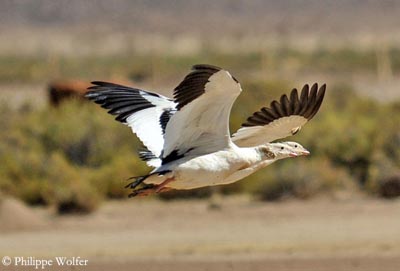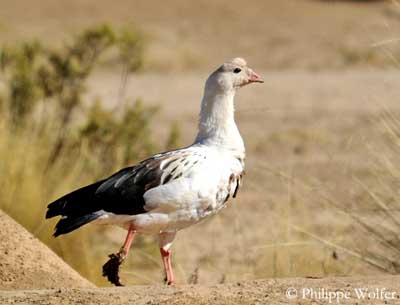
Fr: Ouette des Andes
All : Andengans
Esp : Cauquén Guayata
Ital: Oca delle Ande
Nd: Andesgans
Photographs by Philippe and Aline Wolfer
OISEAUX D’ARGENTINE
Text by Nicole Bouglouan
Sources:
HANDBOOK OF THE BIRDS OF THE WORLD vol 1 by Josep del Hoyo-Andrew Elliot-Jordi Sargatal - Lynx Edicions - ISBN: 8487334105
GUIDE DES CANARDS, DES OIES ET DES CYGNES – de Steve Madge - Delachaux et Niestlé - ISBN: 2603013769
BirdLife International (BirdLife International)
El Zoológico Electrónico (Damisela)
Andean Goose
Chloephaga melanoptera
Anseriforme Order – Anatidae Family
BIOMETRICS:
Length: 70-80 cm
Weight: 2700-3600g
DESCRIPTION:
The Andean Goose is a bird of the high Andes, often seen up to 3000 metres of elevation, and even more.

This is a bulky goose with white plumage overall, except on wings and tail.
Adult has white head, neck, underparts, back, rump and most parts of wings. The wings show glossy black primary flight feathers, great coverts and tertials. Tail is black too. Scapulars have black and white scaled effect.
The short bill is pinkish-red with black nail. Eyes are dark brown surrounded by narrow pink eye-ring. Legs and webbed feet are pinkish-red.
Both sexes have similar plumage, but male is larger than female.
The juvenile is duller than adults, with head and neck washed pale grey, and duller and greyer wings and tail.
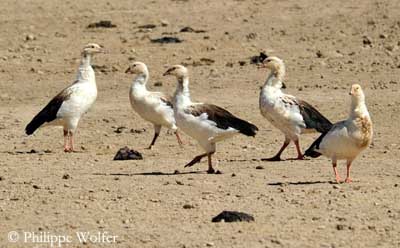
VOICE: SOUNDS BY XENO-CANTO
The Andean Goose male gives soft, high-pitched whistles, a series of “pip pip pip pip…”, whereas the female utters low grunts.
They are noisy during the breeding season.
HABITAT:
The Andean Goose frequents wetlands above 3000 metres of elevation, close to grasslands and pastures.
They perform altitudinal movements by snowy winters, reaching lowlands and large valleys.
RANGE:
The Andean Goose is sedentary in the Andes from C Peru to C Argentina. This species occurs up to 3000 metres of elevation, sometimes more, up to 4700 metres.
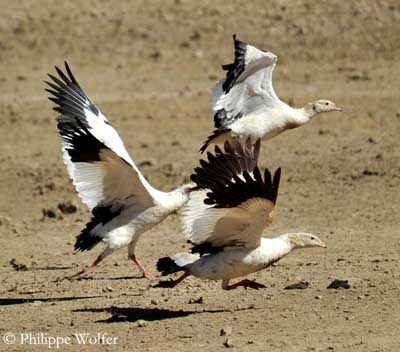
BEHAVIOUR:
The Andean Goose is vegetarian, feeding mainly on grasses, sedges and other fleshy aquatic plants of varied species.
The species is usually found in pairs or family groups, grazing near water at high elevation.
The non-breeding birds remain in flocks all year round, whereas the family group separate before the next nesting period.
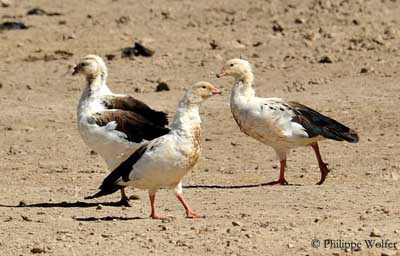
During the breeding season, males are aggressive and strongly defend the young and the territory, using ritual postures with open wings and stretched neck, sometimes accompanied by loud calls. Females only defend the nest-site.
The Andean Goose is not a very good swimmer. It goes to the water if threatened and with the chicks very soon after hatching.
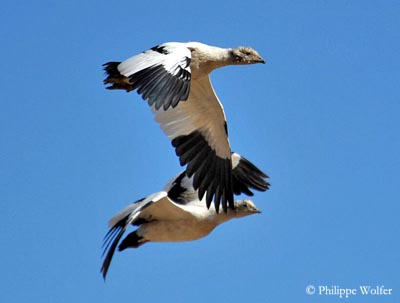
FLIGHT:
The Andean Goose performs slow, heavy flight. The wings are very strong and the flight of this bulky bird requires continuous beating of the wings. The wing muscles are large and well developed, giving the goose its broad-breasted appearance.
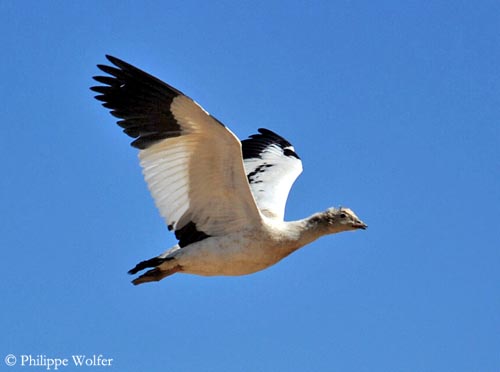
REPRODUCTION:
Breeding season starts in November, (November-January), during the austral spring.
The Andean Goose can be solitary nester or form loose groups. The nest is a shallow depression in the ground, close to the water or not. The cup is made with plant materials. These geese may also use rock crevices for nesting.
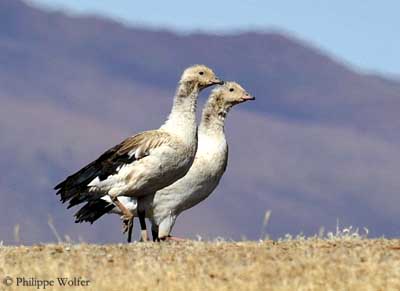
Female lays 5-10 eggs, and incubates during about one month, while the male remains in the surrounding of the site. At hatching, chicks are covered in white down, and show three blackish bands on the upperparts.
As soon as they hatch, the whole family reaches the water where they remain for several weeks, about three months.
The young fledge at 12 weeks after hatching, and can breed at three years.
Both mates remain together all the life, or for several years. They are monogamous.
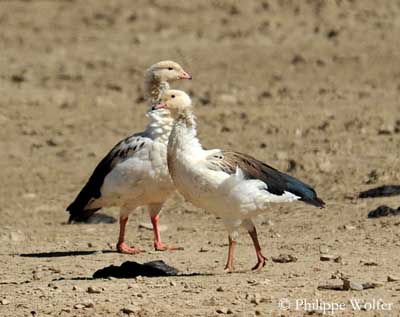
DIET:
The Andean Goose is a vegetarian species, feeding on grasses, sedges and aquatic plants such as Chara, Lilaeopsis, Myriophyllum and Nostoc.
PROTECTION / THREATS / STATUS:
The Andean Goose is common and widespread in most parts of the range. This bird frequents inaccessible areas and is fairly well isolated from human disturbances.
The species is not threatened at this moment.
